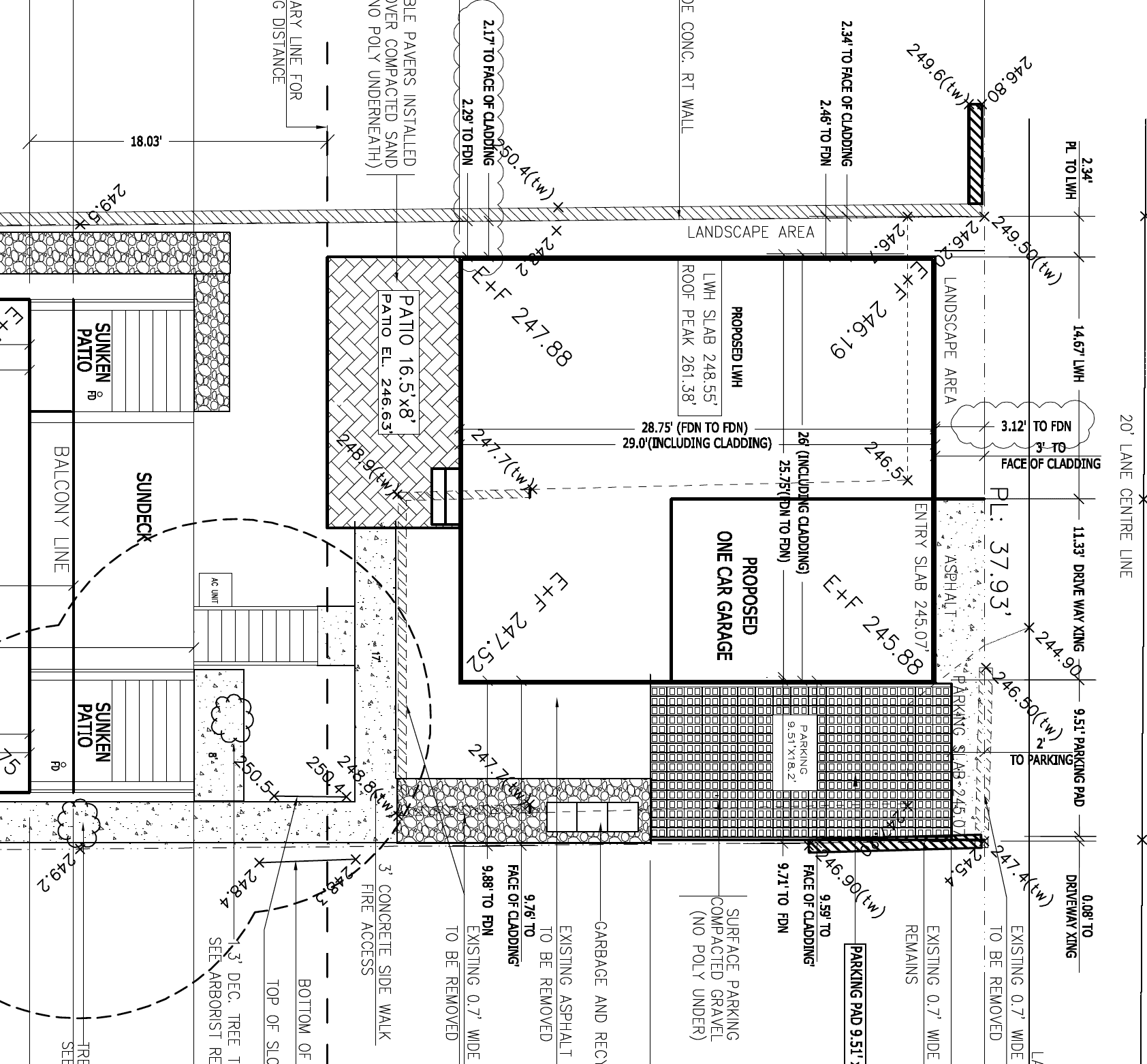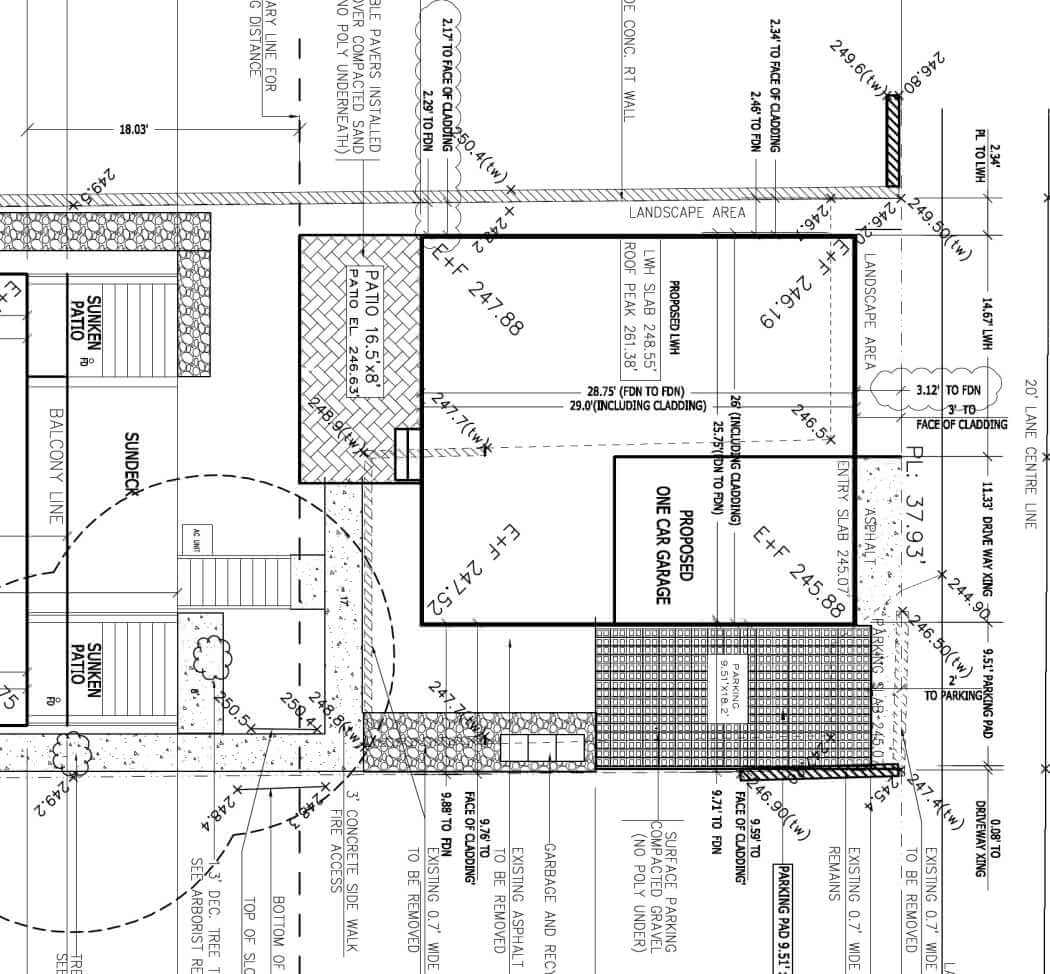
Laneway House Guide, Vancouver
If your thinking about building a laneway house in the City of Vancouver this laneway house guide will help you understand:
- What you need to know when looking to build a laneway house for your home in Vancouver
- An overview of the technical terms you need to know while building a laneway house
- Rules and regulations that you need to know
- Permissible developments within your laneway house
- Insights into the application process
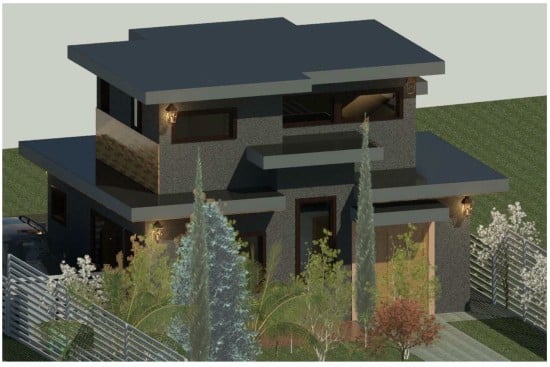
How big can your laneway house be?
Laneway House-
For more Vancouverites, a laneway house can mean access to more money or space. The second house or secondary suite built on an existing lot – often in the backyard – mostly overlooks the back lane of the existing house.
Footprint-
Know the extreme outer limits of the laneway house. For the footprint, include within its purview any buildings, carports, or covered porches except eaves. Take into account steps, or any other projections allowed through the by-laws.
Height-
To calculate the height of the laneway house, take the help of a bit of geometry. Look at the horizontal datum plane, which is the reference point on which the surface elevations are based and measure it in terms of the average of the surface elevations at the intersections of the setback lines. Do this for the front, rear, and side of the property.
Guidelines For Building Laneway House
Where is a laneway house permissible?
This laneway house guide highlights the fact that Laneway house permissible with a new or existing one-family dwelling or one-family dwelling with a secondary suite. Additionally, the following conditions must be met:
- It is located on a site served by an open lane.
- The site is located on a corner served by an open or dedicated lane
- A double-fronting site, meaning it is served at the front and the rear by a street.
What should be the width of the site for the construction of a laneway house?
Generally, the width should not be less than 9.8 m or 32.15 feet. However, under special circumstances, you may be approved for a laneway house if it has a width of at least 7.3 m or 23.95 feet on the discretion of the Director of Planning, who will consider massing and the impact on neighbourhood privacy as well as the application Council policies and guidelines before granting the exception.
Can a laneway house have a basement?
Yes, if the construction of the house has been approved, it can also have a basement.
What if the site has a width of more than 9.8m?
This laneway house guide helps us understand that for a site in the RS-3 and RS-3A Districts and the RS-6 District and the sites of more than 16.8m in the RS-5 District, the width of a laneway house and its accessory should be within the guidelines of provided by the District schedule. Simply stated, read the district guidelines.
Which side should the laneway house be facing, and how many stories can it have?
The laneway house if located on east-west oriented sites needs to be located on the south side. Additionally, laneway houses can only have one storey – or at the most – a partial second storey.
What other accessory restrictions should you keep in mind?
If looking for open balconies, know the restrictions. You also cannot build sun decks or roof decks, be it in a one storey house or on the partial second storey of your house.
What should be the height of a single storey laneway house?
For a flat roof, the height is measured to the highest point of the roof and cannot exceed 4.3m. For a gable or hip roof, we include the mean height level between the eaves and the ridge, and it cannot exceed a height of 5.2 m. Leave that tower for Rapunzel; a quaint house that does justice to the budget (and the Council guidelines).
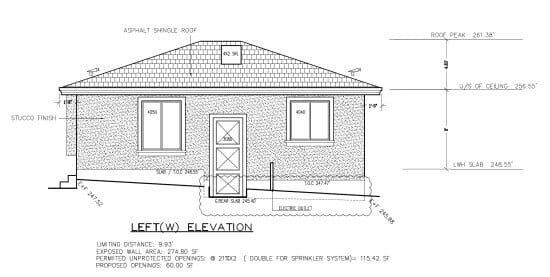
What should the location of the single storey laneway house be?
The laneway house guide highlights that a laneway house has to be within 10.7 m of the ultimate rear property line. Plus, it has to have with a width of at least 4.9 m from the family dwelling and 0.9 m from the rear property line. Additionally, you also need to have a distance from each property line, which is equal to at least 10% of the lot width.
In case of a smaller area, consult the Director of Planning who can offer some relaxation with respect to specific restrictions. The Director of Planning can relax the location by 0.6 m from one side property line for interior lots, or 0.6 m from the inside property line for corner lots.
What about the height of a single storey laneway house with a partial second storey?
Looking to build one storey with a partial second storey? Ensure that its height does not exceed 6.7 m to the ridge of a gable or hip roof with a minimum pitch of 7:12 (this is the slope of the roof in ratio to the horizontal run of the roof-). Or, for a pitch less than 7:12, it should be 5.8 m to the highest point of the roof.
While we are hovering on the topic of height, let us also put it out there that while one may be interested in a modern Tower of Pisa, stick to the guidelines. It says that if the roof pitch is 7:12, one cannot stray from a 4m intersection of the surface of the roof and the exterior wall surface, measured from the horizontal datum plane. Or, if the pitch is less than 7:12, the walls of the partial second storey must be set back at least 0.6 m from the exterior walls of the floor below.
By regularly referring to this laneway house guide you are able to keep these key factors mind when building the laneway house.
Footprint of Laneway house
The footprint of your home is very important, and if you haven’t already guessed or are in the middle of tearing your hair out, there are more guidelines in store.
But don’t stress, we are here to make your task easier. The footprint of your house is the perimeter, which generally houses your parking or other accessory arrangements that do not have a residential utility. Your partial second storey should not exceed 60% of the footprint of the house if your minimum roof pitch is 3:12 or 50% of the footprint if it is less than 3:12. Try not to get confused. There is more ahead.
What about the dormers?
Yes, how can we miss the most important part of the house? What is a laneway house without those quaint little dormers? The rule says that it should be inset at least 0.6 m from the exterior wall of the floor below.
What is the location of a laneway house with a partial single storey?
The first thing you need to know is that this is a bigger house, so there are more rules. The laneway house has to be located within 7.9 m of the ultimate rear property line. Plus, it has to be 4.9 m away from the actual dwelling and at least 0.9 m from the ultimate rear property line, which can also be relaxed if the Director of Planning sees appropriate conditions.
Again, don’t bank upon it. The house also has to be built in conformation with the guidelines of the district schedule.
What should be the floor area of the laneway house?
This is straightforward. It should not exceed the lesser of 0.16 multiplied by the site area, or if you are not willing to calculate, then it should just be 83.6 m2. But it is mandatory that a laneway house must have a minimum area of 26 m2 unless guess who steps in? No brownie points if you guessed it. When the Director of Planning considers the design of the laneway house, they may lessen the minimum floor area to 19 m2.
What about the size of the rooms in the house?
If you have no separate bedrooms, then skip this. But if you are planning to have a bedroom, then the house should have another habitable room that has an area of 16.7 m2 and a minimum dimension of 2.1 m measured between the wall surfaces. The same applies to the bedroom. The dimension remains the same but ensures that the size is a minimum of 8.4 m2. Rooms are where you live out your rainy, sunny, and wintery days. Invest well.
What should the computation of floor area for a laneway house include?
This laneway house guide will help you understand the computation of floor are for a laneway house. This is an exhaustive list, so you’ll need to sit down for it because it is a long list.
- It must include all floors. You have to take into account any earthen floors, for instance, and then measure it to the building’s extreme outer limits.
- Stairways, fire escapes, and other features such as an elevator shaft which is considered to be a part of the measurements for each floor by You-Know-Who (Director of Planning).
- The floor area of the basement, which has been graciously allowed by the Council; remember?
- The floor area enclosed by the covered parking.
- This one is important- if the distance from the floor to the floor above, or in the absence of the floor above, to the top of the roof rafters or deck exceeds 3.7 m, an additional amount equal to the area of the floor area below the excess must also be included. To simplify, if the partial second storey or roof has to cover more area, there is a need add that much in terms of the ground floor.
What must the calculation of floor area exclude?
We apologise, the previous list was just a sneak peek into what is to come. This is the real deal.
First, let us tackle what we “must” exclude while measuring the floor area:
- Areas of floors that are above the upper storey in such a way that cannot be accessed except for with a hatch, or they are adjacent to the upper or only storey but with a height less than 1.2 m.
- Floors located at or below the finished grade with a height of less than 1.2 m. Finished grade refers to the final elevation after the grading of it. If it is only slightly raised, forget about it.
- Covered porches- if their location is at or below the first storey, if they are open on at least one side that is protected by railings, the total excluded floor area does not exceed 3 m2 and where the ceiling height of the total excluded area does not exceed 2.75 m measured from the porch floor and 3% of the total area.
Now that we have got the “musts” out of the way let’s discuss what we “may” exclude from the measurement-
- The open balconies, sundecks, roof decks, or other accessories such as the like face the lane.
- Patios and green roofs but only if You-Know-Who approves of the design of sunroofs, walls, and railings.
- Exclude spaces under sloping roofs with a pitch of at least 3:12 if the vertical distance from floor level to ceiling does not exceed 4.5m, the ceiling attaches directly to the sloping roof rafter, the maximum excluded area does not exceed 25% of the maximum floor space mentioned before and the excluded area, in total, does not exceed 25% of the maximum allowable floor area.
- Can also exclude a staircase area that does not exceed 2.75m2, only if this added with the previously excluded area does not exceed 25% of the maximum allowable floor area.
- Shopaholics can rejoice. Get a little respite on storage spaces such as the linen closet, clothes closet, and the like, provided, it does not exceed 3.7m2.
What to do for a private outdoor space?
The private outdoor space can only have an open balcony, sundeck, or roof deck. Or, have a patio located at grade with a minimum size of 3.7 m2 and a minimum dimension of 1.5 m.
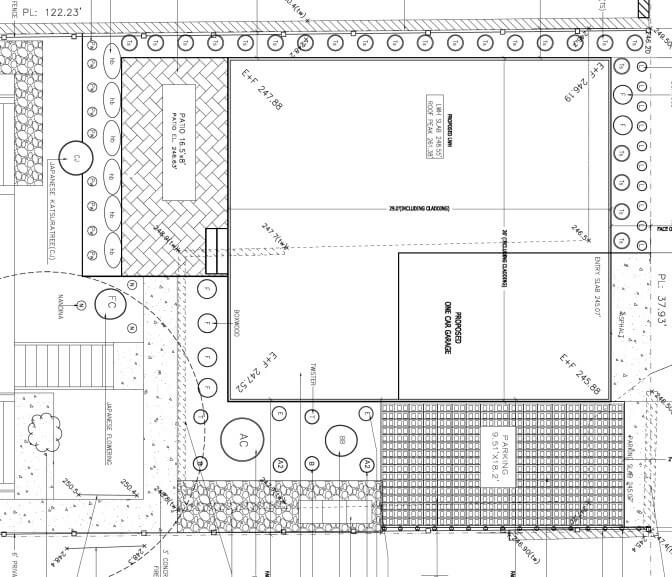
Are there any setback regulations?
If not using a particular end of the property for anything like parking or fire access, ensure that it is permeable and landscaped.
Nobody likes a decrepit house, and it blemishes the entire row of neat houses.
Any other “must-includes”?
The first thing is to include is a 75 mm wide trim around all doors and windows. What is trim? It’s installed along those beautiful those door and window frames – to add in decoration. It also hides the messy lines that meet the ceilings from the doors and windows.
A laneway house must also include a canopy over the main entry door.
Any other do’s with regard to the lane-facing construction?
Yes, there are quite a few.
- A main-entry door that faces the lane must be at least 1.5 m away from the ultimate rear property line because one can’t just open onto the street.
- At least 10% of the building elevation facing the lane must have windows no smaller than 1.1 m2.
- Wall cladding materials on a building elevation facing the lane must be continued in equal proportions, no less than 2.0 m along adjacent sidewalls or 1.2 m where the discontinuation of material occurs at a change in the building wall plane such as a bay or a chimney. Don’t make it ugly; just make it symmetrical because that is what people love.
- However, do note that one or all of the above rules can be done away with if the Director of Planning feels that the design is in sync with the housing regulations, and there is no question to the lack of quality of durability.
At what other points can the Director of Planning use their discretion?
The Director of Planning will supervise every move, and they can see if a certain exemption to a rule or a relaxation is better suited to the house. They can permit certain freedoms if
- The topography of the house is such that literal enforcement would result in unnecessary hardship,
- If the relaxation is necessary to retain a tree,
- If it is necessary to allow a green roof that does not have railings or stair access.
It is all up to the condition of the place, its individual qualities, and peculiarities, and how things would shape up there. This is not a free pass to ask the Director to give a little leeway. It just means that when the rule cannot be applied to a specific situation, the Director has the liberty to give the go-ahead.
Final thoughts
Building a laneway house can seem tricky. It’s important to read through the provisions to not run afoul. Our laneway house guide is intended to help you navigate the complexities of your laneway house project. We’re sure you wish to make an amazing little house, so do your homework, read this not-so-little rulebook and get all your construction knowledge on point.
Your laneway house is something that is not just going to affect you. It will affect your neighbours, your pets, your children, and the community in which you live. If it seems like a daunting task, the team at Silvercrest can help. We are well-equipped to guide you through the process.
Call or email us for your free consultation today!
